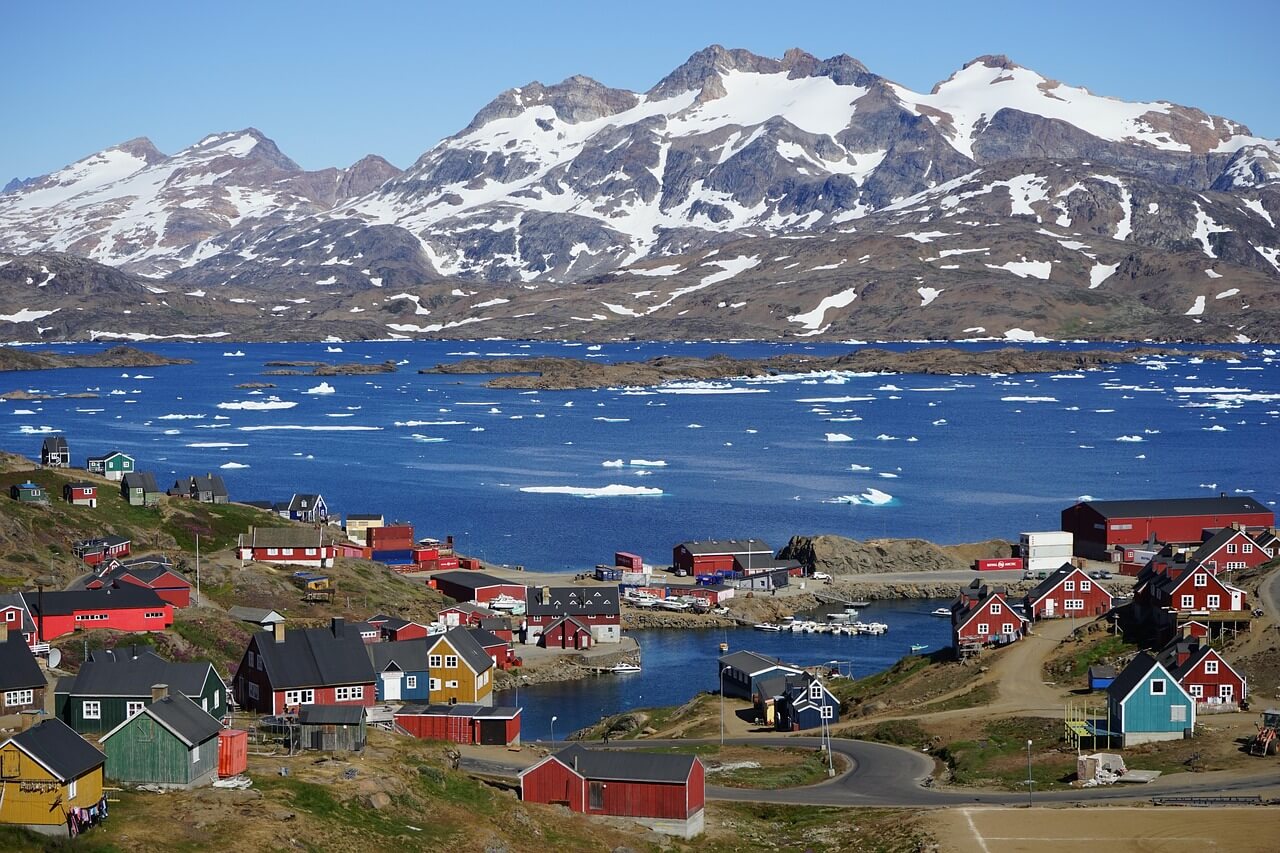When to visit Greenland during the year?
Greenland's climate varies significantly throughout the year, shaping its appeal for different types of tourists. Summer, from June to August, offers nearly 24-hour daylight, making it ideal for exploring the stunning landscapes, waterways, and wildlife. Hiking in the stunning landscapes of South Greenland or whale watching in Ilulissat are major highlights during this time. Winter, from December to February, transforms the country into a winter wonderland, perfect for activities like dog sledding and viewing the Northern Lights. The shoulder seasons of spring (March to May) and autumn (September to November) have their charm, showcasing the melting ice and vibrant fall colors, respectively.
How to get to Greenland?
Traveling to Greenland is an adventure in itself, as the country is accessible mainly by air, with limited ferry services. Due to its remote location, most visitors arrive by plane. Major international flights to Greenland typically connect through Denmark, with options to travel from other continents via hubs like Reykjavik, New York, and Toronto.
- Main airports include Nuuk Airport, Ilulissat Airport, and Kangerlussuaq Airport (the main gateway). Major international routes include:
- Copenhagen, Denmark (CPH) - the primary connection point
- Reykjavik, Iceland (KEF)
- Newark, USA (EWR)
- Toronto, Canada (YYZ)
- Low-cost airlines are limited, but Air Greenland and Icelandair offer competitive rates.
- Typical flight time from Copenhagen to Kangerlussuaq is about 4.5 hours, with additional connections to other cities.
- No direct international bus services to Greenland. Local bus connections exist within Greenland’s towns.
- No train services connect to Greenland due to its geographical isolation.
- No direct road access is available since Greenland is an island.
- Most transportation is done via local taxis and rental services in towns.
Tourist activities in Greenland
Greenland boasts a multitude of activities that cater to different interests. Summer is a great time for outdoor enthusiasts and photographers, with extensive hiking trails and opportunities for kayaking among icebergs. Areas like the Ilulissat Icefjord, a UNESCO World Heritage site, offer breathtaking views and unique ecological experiences. For those seeking adventure, South Greenland provides rich fishing opportunities and cultural excursions to local villages. Furthermore, during winter, you can dive into thrilling sports like skiing and snowmobiling. Experience the magic of the Northern Lights and partake in local traditions like sled dog tours. No matter the season, there's no shortage of exploration in this rugged paradise.
Accommodation in Greenland
Accommodations in Greenland vary from basic guesthouses to upscale hotels, designed to fit different budgets. In capital Nuuk, options range from charming hostels to modern hotels with sea views. Prices generally range from $100 to $400 per night, varying based on tourist season and demand. During peak summer months, rates can increase due to high visitor numbers. Smaller towns like Ilulissat and Qaqortoq also offer cozy lodgings providing authenticity and local charm. Unique experiences can be found in traditional lodges and cabins, which provide easy access to nature and cultural experiences. Booking in advance is recommended, especially in summer.
Food in Greenland
Greenland's cuisine features unique ingredients derived from the land and sea. Traditional dishes often include fresh fish like halibut and salmon, game, and local seafood, such as shrimp and crab. Popular traditional delicacies include ‘kiviak’, a fermented dish made from seabirds, and ‘matak’, which is whale skin. Expect to pay between $15 to $40 for a meal at a local restaurant, with more upscale dining costing higher. Restaurants in Nuuk and Ilulissat offer modern takes on traditional flavors, alongside international cuisines. Visiting a local eatery is a great way to immerse yourself in Greenlandic culture and flavors.
Important numbers and information
- Emergency Services:
- Police: 112
- Ambulance: 112
- Fire Brigade: 112
- Embassy Contacts: Danish Embassy contact for foreign visitors.
- Airports: Kangerlussuaq Airport, Kangerlussuaq, Greenland
- Currency: Greenlandic Krone (DKK), payment by card is common.
- Visa/Passport: Check specific requirements depending on nationality; Schengen rules apply for EU visitors.
What to see in Greenland?
Greenland is a treasure trove of natural wonders and cultural heritage. Start your journey in Nuuk, the vibrant capital where you can explore museums showcasing indigenous culture. The Ilulissat Icefjord is a must-see for its majestic glaciers and ice formations, offering breathtaking views. Visit the picturesque town of Sisimiut for a glimpse of traditional Greenlandic life. Don’t miss the stunning Qaqortoq, famed for colorful houses and a rich history. The Northern Lights provide a spectacular nighttime show in winter, while the midnight sun lights up the summer landscape. Each region boasts unique attraction, making every part of Greenland worth experiencing.
History, geography and climate
Greenland's history is a tapestry woven with indigenous cultures, Norse exploration, and colonial influences. The Inuit have inhabited Greenland for thousands of years, living in harmony with the land. Geographically, this vast island features snow-capped mountains, icy fjords, and expansive tundras, with the majority covered by an ice sheet. Its climate is Arctic, with temperatures ranging from -30°C in winter to 10°C in summer. The combination of remote landscapes and resilient communities adds to its unique character, showcasing a land shaped by nature and history.
Population and culture
Greenland's population is around 56,000, predominantly Inuit, with a rich cultural heritage that influences daily life. Greenlandic and Danish are the official languages, reflecting its historical ties. The predominant religion is Christianity, with unique expressions of faith in local communities. Cultural traditions are vibrant, consisting of storytelling, music, and festivals that celebrate the Inuit way of life. Major holidays include national celebrations and traditional events honoring nature. Greenland’s culture is distinguished by its strong connection to the environment, with art often inspired by natural elements, showcasing the island's spirit.








